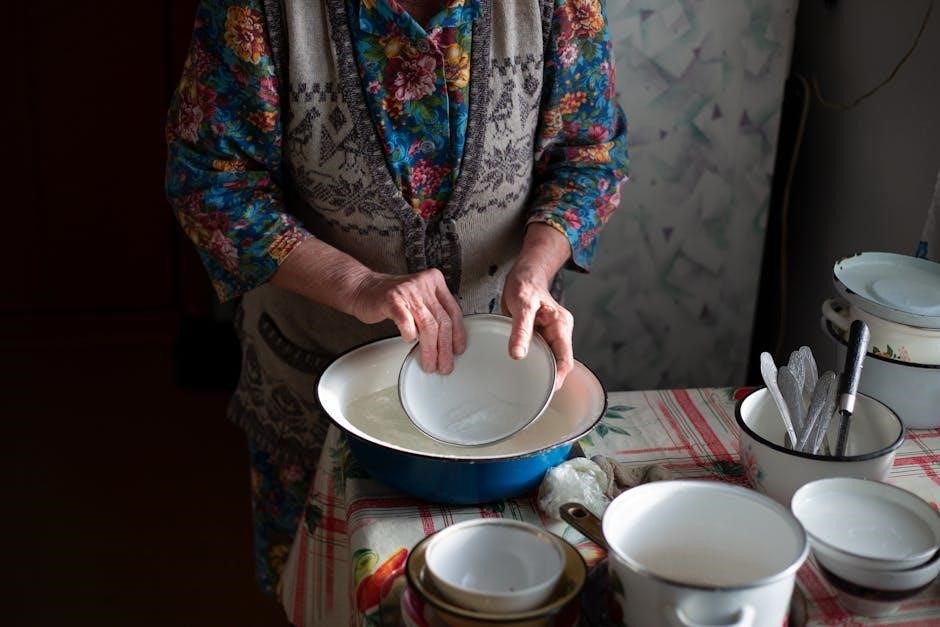Manual regeneration in water softeners is a user-initiated process, typically involving a knob or button. It ensures efficient water softening and system maintenance, offering control and cost-effectiveness.
1.1 What is Manual Regeneration?
Manual regeneration is a process where you initiate the water softener’s cleaning cycle by pressing a button or turning a knob. It involves reversing the ion exchange process to remove accumulated minerals, ensuring the resin beads are cleaned. This method requires user intervention, unlike automatic systems, and is typically done when water hardness increases or system performance decreases.
1.2 Importance of Regular Regeneration
Regular regeneration is essential to remove accumulated minerals, ensuring soft water quality and preventing scaling. It maintains system efficiency, prevents resin degradation, and avoids hard water issues. Consistent regeneration keeps the softener functioning optimally, safeguarding appliances and plumbing from mineral buildup.

The Regeneration Process in Manual Water Softeners
Manual regeneration involves a series of steps, including backwash, brine draw, slow rinse, fast rinse, and brine tank refill, to restore softening capacity and ensure clean water.
2.1 Step 1: Backwash Phase
During the backwash phase, water flows in reverse to remove impurities and sediment. This step ensures resin efficiency and prevents clogging. It typically lasts around 10 minutes, preparing the system for the next regeneration steps. Proper backwashing is crucial for maintaining optimal system performance and water quality.
2.2 Step 2: Brine Draw Cycle
The brine draw cycle involves drawing brine solution from the brine tank and passing it through the resin beads; This step recharges the resin by replacing calcium and magnesium ions with sodium ions. The concentrated brine solution dissolves and flows through the resin, restoring its softening capacity. This phase is essential for effective ion exchange and system performance. Proper brine flow ensures optimal regeneration.
2.3 Step 3: Slow Rinse
The slow rinse phase involves a low-flow rinse to remove excess brine from the resin bed. This step ensures the resin isn’t disturbed, preventing any disruption to the softening process. It prepares the system for normal operation, ensuring water quality remains high and the system runs efficiently. Proper slow rinsing is vital for maintaining optimal water softening performance and longevity.
2.4 Step 4: Fast Rinse Cycle
The fast rinse cycle uses increased water flow to thoroughly flush out remaining brine and residues from the resin bed. This step ensures the system is clean and free of excess salt, restoring its capacity to soften water effectively. The fast rinse prepares the softener for normal operation, ensuring optimal water quality and system performance. It is a critical final cleansing phase.
2.5 Step 5: Brine Tank Refill
The final step involves refilling the brine tank with saltwater to replenish the brine solution used during regeneration. This ensures the system is prepared for the next cycle. The brine tank refill is typically automatic, maintaining optimal salt levels for future softening processes. Proper salt levels are crucial for efficient ion exchange and system performance, preventing hard water issues.
How Often Should Manual Regeneration Occur?
Manual regeneration frequency depends on water usage and hardness levels. Typically, regenerating every 6 months ensures optimal performance, but adjust based on specific household needs and water conditions;
3.1 Factors Influencing Regeneration Frequency
The frequency of manual regeneration depends on water hardness, usage patterns, and household size. Higher water demand or extreme hardness may require more frequent cycles. Salt levels, system maintenance, and the softener’s capacity also play a role. Monitoring these factors ensures optimal performance and prevents inefficiencies, maintaining soft water quality and system longevity effectively.
3.2 Determining the Right Schedule
Determining the optimal regeneration schedule involves assessing water usage patterns, hardness levels, and softener capacity. Monitoring salt levels and system performance helps tailor the frequency. A consistent schedule, often weekly, ensures efficiency. Adjustments may be needed based on seasonal demand or specific household needs to maintain water quality and system performance effectively over time.

Benefits of Manual Regeneration
Manual regeneration offers control over the process, ensuring efficiency and cost-effectiveness. It allows users to initiate regeneration as needed, maintaining optimal performance and water quality consistently.
4.1 Control Over the Process
Manual regeneration allows users to initiate the process directly, providing full control over when and how the system regenerates. This flexibility is ideal for specific situations, enabling customization of the regeneration schedule based on water usage patterns. It ensures the system operates efficiently, preventing unnecessary cycles and maintaining optimal water quality consistently.
4.2 Efficiency and Cost-Effectiveness
Manual regeneration optimizes water and salt usage by allowing users to initiate cycles only when necessary. This reduces waste and lowers operational costs compared to automatic systems, which may run unnecessary cycles. By directly controlling the process, users ensure efficient resource conservation, making manual regeneration a cost-effective solution for maintaining water softener performance and extending system lifespan.

Troubleshooting Common Issues
Identify issues like incomplete regeneration cycles or persistent water hardness. Check salt levels, ensure proper water flow, and inspect for blockages to resolve common problems effectively.
5.1 Identifying When Regeneration is Needed
Signs indicating the need for regeneration include increased water hardness, reduced system efficiency, or longer regeneration cycles. Monitoring water quality and system performance regularly helps determine when manual intervention is necessary to maintain optimal softening effectiveness and prevent mineral buildup in the resin bed.
5.2 Resolving Common Problems
Common issues during manual regeneration include incomplete cycles or low salt levels. To resolve these, check salt levels, ensure the brine tank is filled, and verify proper button functionality. If problems persist, inspect for blockages or system malfunctions. Regular maintenance and troubleshooting ensure optimal performance and extend the lifespan of your water softener system.
Manual vs. Automatic Regeneration
Manual regeneration requires user initiation, offering control, while automatic regeneration runs on preset schedules. Both ensure efficient water softening but differ in convenience and operational involvement.
6.1 Key Differences
Manual regeneration requires user initiation, typically via a knob or button, and is performed as needed. Automatic regeneration runs on a preset schedule, often at 2AM, ensuring hands-free operation. Manual systems offer control and efficiency, while automatic systems provide convenience, though they may regenerate unnecessarily if not properly configured.
6.2 Which is Better for Your Needs?
Manual regeneration suits those who prefer control and cost-efficiency, ideal for small households with predictable water usage. Automatic regeneration is better for busy individuals or large families, offering convenience and consistency. Choose manual if you want to optimize resource use, or automatic for hands-free operation and peace of mind.

Step-by-Step Guide to Manual Regeneration
Initiate manual regeneration by pressing the “Regen” button or turning the knob. The process includes backwash, brine draw, slow rinse, and fast rinse cycles, ensuring optimal system performance.
7.1 Preparing for Regeneration
Before starting manual regeneration, inspect the system for wear or damage. Ensure the drain is clear, salt levels are adequate, and water supply is shut off. Avoid interruptions during the cycle, as this may affect efficiency. Ensure all connections are secure. The process typically takes 1.5 hours, so plan accordingly to maintain soft water availability.
7.2 Initiating the Process
To initiate manual regeneration, locate the Regen button on your water softener. Press and hold it for 5 seconds until the display confirms regeneration. Ensure the system acknowledges the command, often indicated by a flashing light or message. This step ensures the cycle begins correctly, preparing the system to remove minerals and restore softening efficiency effectively.
7.3 Monitoring and Completing the Cycle
Monitor the regeneration cycle by observing the system’s indicators or sounds signaling phase changes. The process typically lasts 1.5 hours, completing with a fast rinse. Once done, ensure the brine tank is refilled and salt levels are adequate. Check for soft water output to confirm successful regeneration and system readiness for use.
Maintenance Tips After Regeneration
After regeneration, check salt levels in the brine tank and replenish as needed. Ensure the system operates efficiently by monitoring water softness and addressing any issues promptly.
8.1 Checking Salt Levels
After regeneration, it’s crucial to check salt levels in the brine tank. Low salt can reduce efficiency and lead to hard water. Inspect the tank visually, ensuring it’s at least one-quarter full. If levels are low, refill with recommended salt or potassium chloride. This ensures optimal performance and maintains soft water quality consistently.
8.2 Ensuring System Efficiency
Regular maintenance is key to system efficiency. Monitor the regeneration process to ensure all cycles complete successfully. Check for blockages and clean components as needed. Maintaining proper salt levels and ensuring the resin bed is clean prevents mineral buildup. This helps sustain optimal performance and guarantees consistent soft water delivery over time.
Manual regeneration is an essential process for maintaining water softener efficiency, ensuring consistent soft water delivery and system longevity through proper maintenance and timely interventions.
9.1 Summary of Key Points
Manual regeneration involves user-initiated processes to clean water softeners, ensuring efficient ion exchange. It includes steps like backwash, brine draw, and rinse cycles, optimizing system performance. Regular maintenance prevents hard water issues, extends equipment life, and maintains water quality. Proper scheduling and monitoring are essential for consistent results and cost-effectiveness.
9.2 Final Thoughts on Manual Regeneration
Manual regeneration offers a reliable method to maintain water softeners, ensuring optimal performance and water quality. By understanding and following the process, users can extend system longevity and enjoy consistent soft water. Regular maintenance and monitoring are crucial for efficiency, making manual regeneration a practical choice for those seeking control over their water treatment needs.
